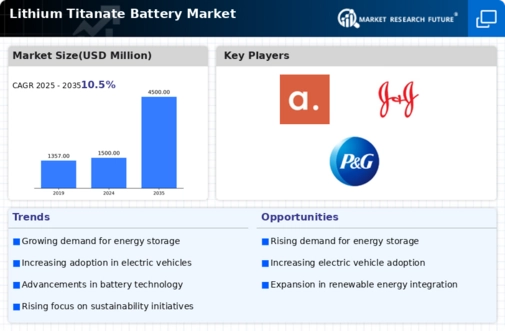Market Share
Lithium Titanate Battery Market Share Analysis
The Lithium Titanate Battery Market is undergoing strategic shifts as companies strive to establish a strong foothold in the rapidly evolving energy storage sector. To gain a competitive edge, businesses are deploying various market positioning strategies that encompass technological innovation, sustainability, and strategic collaborations. Here are key strategies employed in the market share positioning of Lithium Titanate Batteries: Technological Advancements and Performance Enhancement: Leading companies focus on continuous research and development to introduce technological advancements in lithium titanate batteries. This includes improvements in energy density, charging speed, and overall performance. Innovation in electrode materials, cell design, and manufacturing processes contributes to positioning manufacturers as pioneers in the development of high-performance lithium titanate batteries. Diverse Application Focus: To broaden market reach, companies tailor lithium titanate batteries to diverse applications such as electric vehicles, renewable energy storage, and grid stabilization. Addressing a variety of industry needs enhances the versatility of the batteries and attracts a broader customer base. Offering batteries with specifications suitable for different applications allows manufacturers to capture market share across multiple sectors. Sustainability and Environmental Responsibility: In response to growing environmental concerns, lithium titanate battery manufacturers are emphasizing sustainability. This includes the use of eco-friendly materials, recyclability, and a commitment to reducing the environmental impact of battery production. Positioning lithium titanate batteries as environmentally responsible aligns with global sustainability goals and appeals to environmentally conscious consumers and businesses. Strategic Collaborations and Partnerships: Collaborative efforts with other players in the energy storage ecosystem, such as electric vehicle manufacturers or renewable energy developers, form a strategic approach. Partnerships enable companies to create integrated solutions that cater to the broader needs of the market. Joint ventures and collaborations enhance the overall value proposition, making a company more attractive to customers seeking comprehensive energy storage solutions. Global Market Expansion: Companies aiming for increased market share strategically expand their global presence. This involves establishing partnerships, entering new markets, and adapting products to meet diverse international standards. A global footprint not only widens the customer base but also positions a company as a reliable supplier capable of meeting the diverse needs of an international clientele. Emphasis on Safety and Reliability: Safety and reliability are paramount in the lithium titanate battery market. Companies invest in rigorous testing, quality control measures, and safety certifications to ensure their batteries meet the highest industry standards. Emphasizing the safety and reliability of lithium titanate batteries instills confidence in customers, contributing to brand trust and long-term market share growth. Education and Training Initiatives: To facilitate market adoption, companies invest in educational initiatives aimed at customers and industry professionals. Providing training on the proper use, maintenance, and advantages of lithium titanate batteries ensures users maximize the benefits of the technology. Educated consumers are more likely to make informed choices and contribute to the positive market positioning of lithium titanate batteries. Cost Competitiveness and Economic Viability: In a competitive market, cost competitiveness is crucial. Efficient manufacturing processes, economies of scale, and strategic sourcing of materials contribute to competitive pricing. Offering cost-effective lithium titanate batteries without compromising quality positions a company as a financially viable option, appealing to a wide range of customers.







Leave a Comment